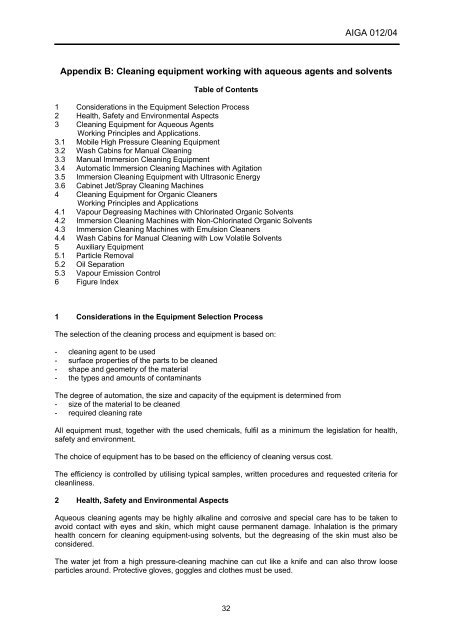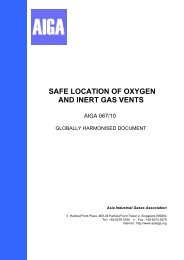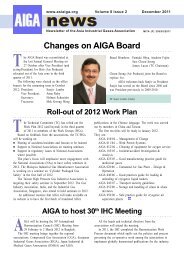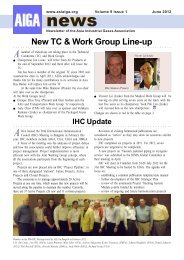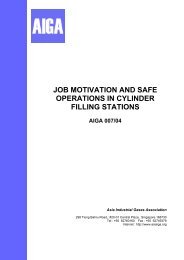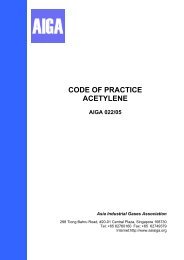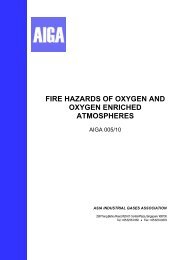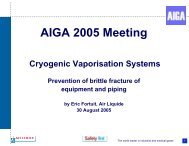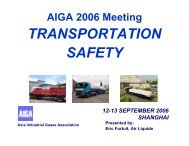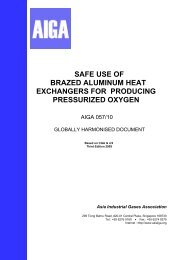CLEANING OF EQUIPMENT FOR OXYGEN SERVICE - AIGA
CLEANING OF EQUIPMENT FOR OXYGEN SERVICE - AIGA
CLEANING OF EQUIPMENT FOR OXYGEN SERVICE - AIGA
You also want an ePaper? Increase the reach of your titles
YUMPU automatically turns print PDFs into web optimized ePapers that Google loves.
32<br />
<strong>AIGA</strong> 012/04<br />
Appendix B: Cleaning equipment working with aqueous agents and solvents<br />
Table of Contents<br />
1 Considerations in the Equipment Selection Process<br />
2 Health, Safety and Environmental Aspects<br />
3 Cleaning Equipment for Aqueous Agents<br />
Working Principles and Applications.<br />
3.1 Mobile High Pressure Cleaning Equipment<br />
3.2 Wash Cabins for Manual Cleaning<br />
3.3 Manual Immersion Cleaning Equipment<br />
3.4 Automatic Immersion Cleaning Machines with Agitation<br />
3.5 Immersion Cleaning Equipment with Ultrasonic Energy<br />
3.6 Cabinet Jet/Spray Cleaning Machines<br />
4 Cleaning Equipment for Organic Cleaners<br />
Working Principles and Applications<br />
4.1 Vapour Degreasing Machines with Chlorinated Organic Solvents<br />
4.2 Immersion Cleaning Machines with Non-Chlorinated Organic Solvents<br />
4.3 Immersion Cleaning Machines with Emulsion Cleaners<br />
4.4 Wash Cabins for Manual Cleaning with Low Volatile Solvents<br />
5 Auxiliary Equipment<br />
5.1 Particle Removal<br />
5.2 Oil Separation<br />
5.3 Vapour Emission Control<br />
6 Figure Index<br />
1 Considerations in the Equipment Selection Process<br />
The selection of the cleaning process and equipment is based on:<br />
- cleaning agent to be used<br />
- surface properties of the parts to be cleaned<br />
- shape and geometry of the material<br />
- the types and amounts of contaminants<br />
The degree of automation, the size and capacity of the equipment is determined from<br />
- size of the material to be cleaned<br />
- required cleaning rate<br />
All equipment must, together with the used chemicals, fulfil as a minimum the legislation for health,<br />
safety and environment.<br />
The choice of equipment has to be based on the efficiency of cleaning versus cost.<br />
The efficiency is controlled by utilising typical samples, written procedures and requested criteria for<br />
cleanliness.<br />
2 Health, Safety and Environmental Aspects<br />
Aqueous cleaning agents may be highly alkaline and corrosive and special care has to be taken to<br />
avoid contact with eyes and skin, which might cause permanent damage. Inhalation is the primary<br />
health concern for cleaning equipment-using solvents, but the degreasing of the skin must also be<br />
considered.<br />
The water jet from a high pressure-cleaning machine can cut like a knife and can also throw loose<br />
particles around. Protective gloves, goggles and clothes must be used.


